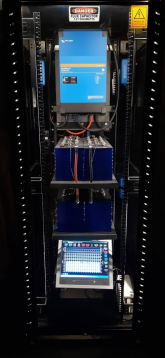Rui Ponte
New Member
- Joined
- Nov 25, 2019
- Messages
- 73
12kW inverting / charging
Super proud of my build! ?
Thank you all for sharing your knowledge. That's what made this build possible! ?
Note: I made some upgrades from 2020 to 2022 and, therefore, some pictures may be outdated!
- 3 x Victron Multiplus II 5000VA in 3-phase configuration
- 12 x 270W Jinko coupled with Victron Smartsolar 250/60
- 12 x 280W JA Solar coupled with Victron Smartsolar 250/60
- 8 x 410W JA Solar coupled with Victron Smartsolar 250/70
- Cells: 32x280Ah LiFePo4 in 16S2P 48V, 20mm x 5mm custom built busbars and 70mm2 cabling
- BMS: Batrium WM4 + 16 BlockMons 8
- DC Breaker: 150A Carling Tech (FA1-B0-14-815-12A-BG)
- 42U rack mount
- Custom 680x420mm steel grate shelves
- Power bill minimization:
- Peak shaving to minimize contracted power:
- Flexible load: EV charger adjusting power dynamically
- If above is not enough, the following loads can be interrupted: heat pump; pool pump; house dehumidifier; other
- Arbitrage: charging from grid and/or selling to grid, for profit
- Load shifting to maximize peak shaving and arbitrage:
- EV charger: flexible charging to achieve the user-set charging target
- Heat pump: flexible temperature setpoints + thermal storage in heated floor;
- Pool pump: flexible hourly/daily working hours, to achieve weekly working hours target
- House dehumidifier: flexible humidity target
- Peak shaving to minimize contracted power:
- Power Backup: if the grid goes out, the entire house switches to island-mode seamlessly (less than 20ms).
- Some specs:
- Inputs for the system's decision-making:
- Next-day PV production forecast
- Electricity prices: next-day hourly wholesale price (for sale) & consumer tariff
- User setpoints
- The brains: a Home Assistant server connecting everything, with most programming made in MQTT.
- Inputs for the system's decision-making:
Super proud of my build! ?
Thank you all for sharing your knowledge. That's what made this build possible! ?
Note: I made some upgrades from 2020 to 2022 and, therefore, some pictures may be outdated!
Attachments
Last edited:





















